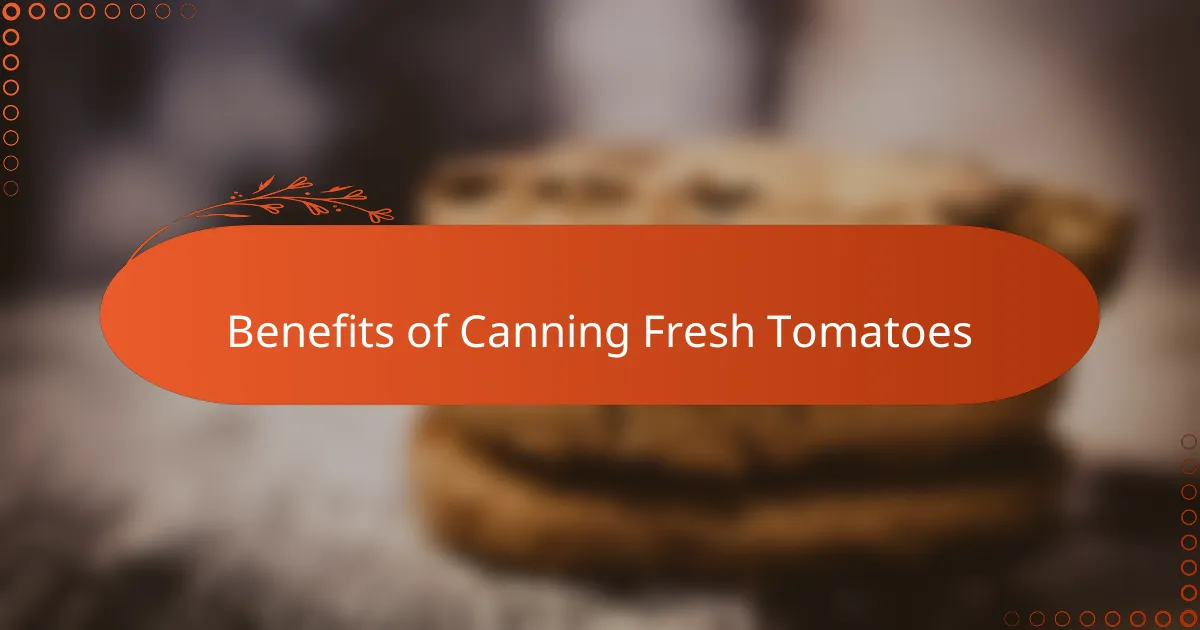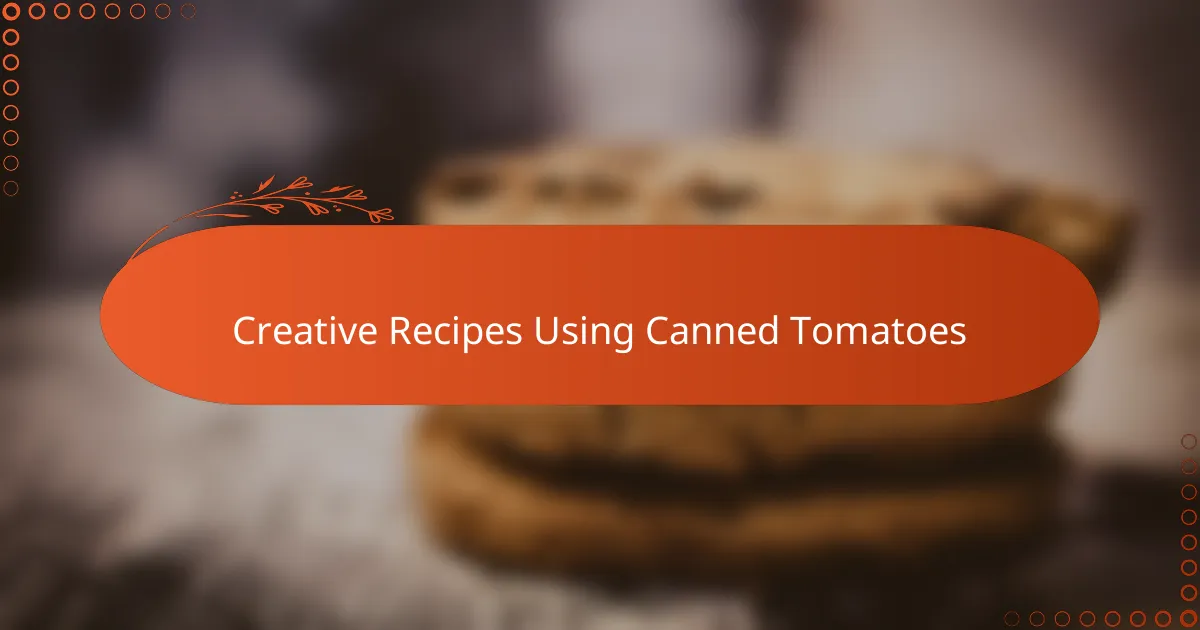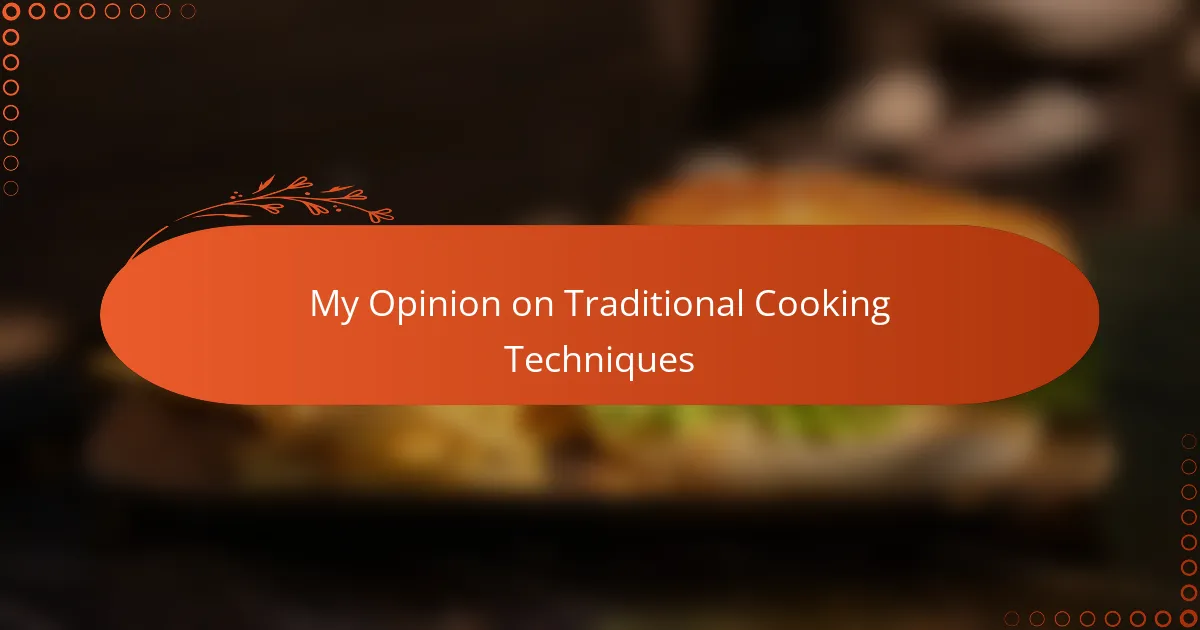Key takeaways
- Canning fresh tomatoes preserves their vibrant flavor, providing a burst of summer taste in winter meals.
- Essential tools like a canner and jar lifter enhance the safety and efficiency of the canning process.
- Maintaining the right acidity and removing air bubbles are crucial for successful canning and preventing spoilage.
- Canned tomatoes serve as a versatile ingredient for various dishes, elevating them with rich flavors even in off-seasons.

Introduction to Canning Tomatoes
Canning fresh tomatoes always feels like capturing summer’s essence and bottling it for the colder months. I remember the first time I boiled those plump, sun-warmed tomatoes, wondering if the end result would taste as vibrant as the garden they came from. Have you ever thought about how such a simple process can preserve not just food, but memories and moments too?

Benefits of Canning Fresh Tomatoes
There’s something truly satisfying about opening a jar of home-canned tomatoes in the dead of winter and tasting that burst of summer sunshine. I often think about how canning preserves the fresh flavor in a way that nothing frozen or store-bought can match. Have you ever noticed how a jar of canned tomatoes can make a stew or sauce feel like it was made from scratch that same day?
Beyond the flavor, canning fresh tomatoes gives you control over what goes into your food—no preservatives, just pure, ripe tomatoes and a pinch of salt if you like. From my experience, knowing exactly what’s inside each jar brings a comforting sense of security, especially for families wanting to eat healthier. Isn’t it wonderful to rely on your own pantry rather than heading to the grocery store for canned goods?
Lastly, the process itself has a rhythm that I find calming. The chopping, boiling, and sealing require focus but leave room for reflection. Each jar lined up on the shelf feels like a small victory, a stored treasure that connects me to the land and seasons. Have you ever felt that quiet pride when your pantry is filled with homemade preserves?

Essential Tools for Canning
When I started canning, the first thing I realized was how essential the right tools are—they make the process feel manageable rather than overwhelming. A large pot with a fitted lid, often called a canner, is my go-to; it’s where the magic happens as it safely processes the jars. Have you ever tried using a regular pot and ended up crouched on the floor, carefully balancing jars? Trust me, a proper canner changes all that.
Another tool I can’t live without is a jar lifter. It sounds simple, but gripping hot jars with bare hands is both risky and stressful. The lifter gave me confidence, like an extra set of hands protecting my precious tomatoes and me. It made the whole experience feel safer and more professional—something I wish I had known about from day one.
Don’t underestimate the small things, either: a wide-mouth funnel keeps your workspace clean when filling jars, and a bubble remover helps get rid of those pesky air pockets that can mess with preservation. These little tools might seem trivial, but they smooth out the process in ways I only recognized after a few cautious first attempts. Have you noticed how the right tools not only protect your food but also boost your canning confidence?

Step by Step Canning Process
The first step I always take is to wash and peel the tomatoes; this part feels like prepping the stars for their big performance. I usually score a small “X” on the bottom before blanching them briefly in boiling water, which makes peeling easier and less frustrating — have you ever struggled to peel stubborn skin only to give up halfway? That simple blanching step transformed my method, turning a fiddly task into almost a satisfying ritual.
Next, I fill sterilized jars with the hot tomatoes, leaving just the right amount of headspace so that nothing spills over during processing. Adding a pinch of salt or a splash of lemon juice not only boosts flavor but also ensures safety—acid plays a vital role in canning tomatoes, something I learned the hard way on my first batch that turned out a little too tangy. Have you experimented with seasonings, or do you prefer your tomatoes plain and simple?
Finally, the jars go into the canner filled with boiling water, covering them by at least an inch. The waiting can feel tense, but it’s a necessary pause to kill any lurking bacteria. Watching those jars bubble away always brings me a strange sense of accomplishment—like each hiss and pop marks a little victory over time and spoilage. Do you find that the process becomes meditative once you settle into the rhythm?

Common Challenges and Solutions
One challenge I often face is maintaining the right acidity level to prevent spoilage. Early on, I learned the importance of adding lemon juice or citric acid—skipping this step once resulted in a batch that barely lasted a week. Have you ever wondered why some jars seem perfect while others don’t keep as well? That simple adjustment made all the difference for me.
Another hurdle is dealing with air bubbles trapped inside the jars. At first, I didn’t bother removing them properly, and the lids sometimes didn’t seal correctly. Using a plastic spatula to gently coax out those stubborn bubbles became a game changer. Have you tried this little trick, or do you just hope for the best and cross your fingers?
Sometimes, the timing can be tricky, especially fitting the processing into a busy day. I remember one autumn when I started too late and had to rush through the final steps, which left me anxious about safety and quality. Now, I always plan ahead, setting aside plenty of time so the process feels calm and controlled. Isn’t it amazing how a little preparation can turn a stressful chore into a peaceful ritual?

Tips from My Canning Experience
One tip that transformed my canning experience was learning to trust the timing carefully. I used to rush, thinking the tomatoes would be fine if I just pushed through. But after nearly ruining a batch, I realized that patience—letting the jars process fully—is the real key to safety and flavor. Have you ever been tempted to cut corners, only to wish you’d taken more time?
Another detail I didn’t appreciate enough at first was how crucial it is to check the seals once jars have cooled. I once stored a batch thinking they were sealed perfectly, only to find a few jars that hadn’t latched properly, which was disappointing and frustrating. Now, I tap each lid and give it a gentle press before shelving. Do you have a seal-check routine that puts your mind at ease?
Lastly, I can’t stress enough how valuable it is to keep your workspace clean and organized throughout. Between wiping spills immediately and having a place for every tool, the whole process feels less chaotic and more enjoyable. It’s a small practice, but it made me feel more in control and less like I was just scrambling to keep up. Have you noticed how a tidy station helps you focus on the important parts of canning?

Creative Recipes Using Canned Tomatoes
There’s something magical about how canned tomatoes become the secret ingredient that instantly elevates simple dishes into comforting meals. I often reach for my jars when I want to create a rustic tomato soup that tastes like it was simmered all day, even though it came together in under 30 minutes. Have you ever noticed how canned tomatoes add that deep, rich flavor that fresh tomatoes sometimes struggle to deliver in winter recipes?
One of my favorite ways to get creative is by transforming canned tomatoes into a vibrant shakshuka, where the tomatoes meld beautifully with spices and eggs for a hearty breakfast or brunch. It’s a dish that not only warms the kitchen but also sparks a feeling of accomplishment, knowing those tomatoes come straight from my own pantry. Have you tried turning your canned tomatoes into something surprising beyond just sauce?
And let me tell you, canned tomatoes are fantastic for homemade sauces, stews, and even baked dishes like lasagna or eggplant parmigiana. Their versatility saved me countless times when fresh tomatoes were out of season, proving that with a little imagination, those humble jars can be the centerpiece of countless flavorful meals. What’s your go-to recipe that always benefits from a jar of canned tomatoes?



